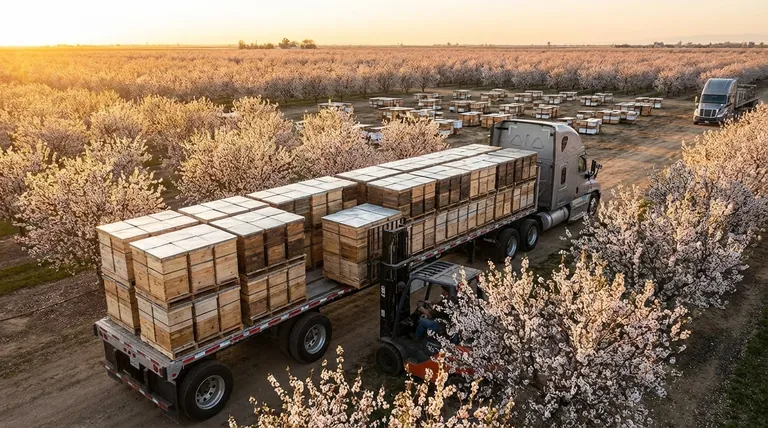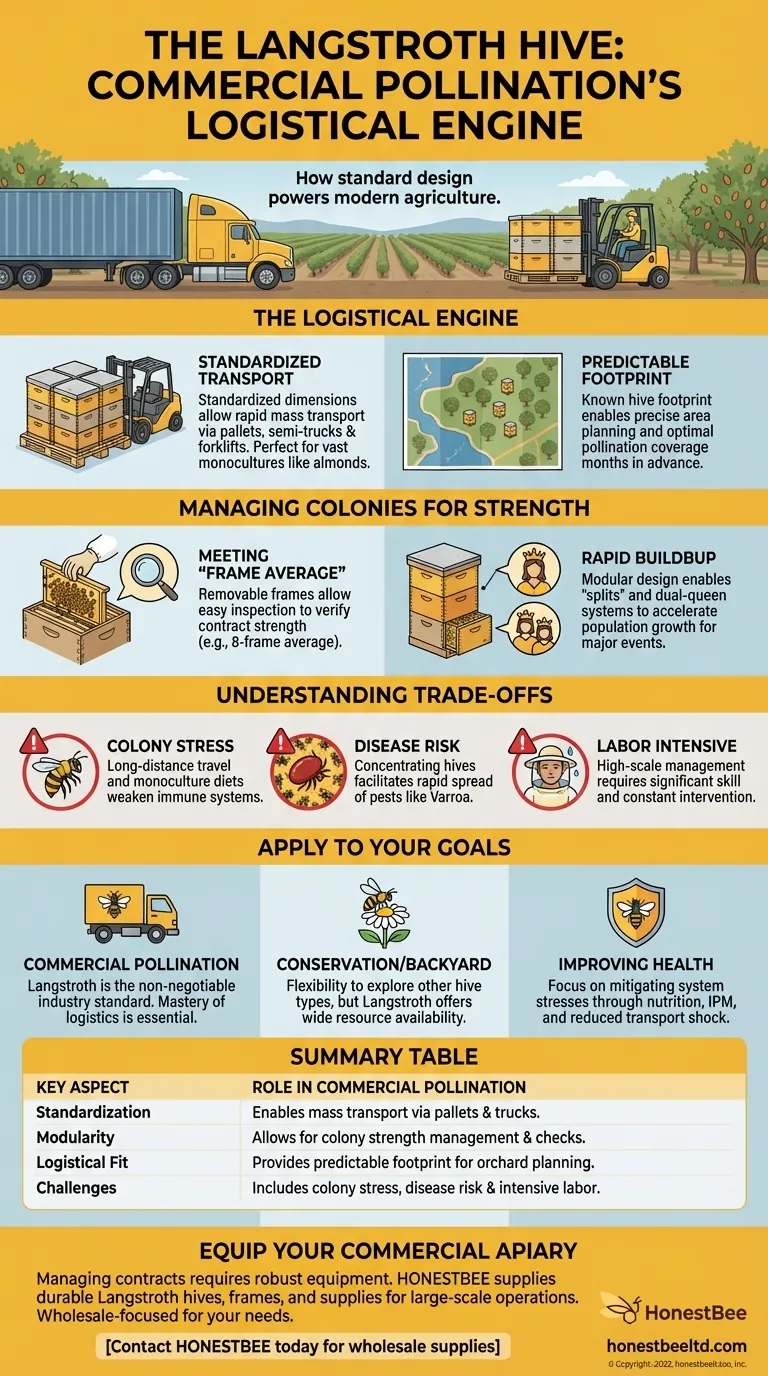In short, Langstroth hives are the backbone of commercial pollination because their standardized, modular design is perfectly suited for the industrial logistics of modern agriculture. Their uniform size allows for efficient transportation on pallets via semi-trucks and forklifts, while their interchangeable components enable beekeepers to manage colony strength to meet specific contractual demands.
The Langstroth hive's success in commercial pollination is not just about housing bees. It's about treating the colony as a standardized, mobile, and manageable unit that can be deployed at an immense scale to meet the needs of industrial farming.

The Logistical Engine of Pollination
The primary reason for the Langstroth hive's dominance is its seamless integration with modern supply chains. The design prioritizes efficiency and predictability over all else.
Standardization for Mass Transport
The Langstroth hive's dimensions are globally recognized and standardized. This uniformity is the key to large-scale transport.
Hives are typically arranged four to a pallet, allowing them to be moved quickly and safely with forklifts. This enables the rapid loading and unloading of hundreds or thousands of hives from semi-trucks, a critical capability for pollinating vast monocultures like California's almond orchards.
A Predictable Footprint
Standardization also means each hive unit has a known footprint. Orchard managers and beekeepers can precisely calculate how many hives can fit in a specific area and distribute them for optimal pollination coverage.
This predictability removes guesswork and allows for the creation of detailed logistical plans months in advance of the pollination season.
Managing Colonies for Contractual Strength
Commercial pollination is a service with contractual obligations. Growers pay for colonies of a certain strength, and the Langstroth hive's design is essential for beekeepers to meet these requirements.
Meeting the "Frame Average"
Pollination contracts, particularly for high-value crops like almonds, often specify a minimum colony strength, such as an "8-frame average." This means the average hive must have at least eight frames covered with bees.
The Langstroth's removable frames allow for easy inspection by beekeepers and third-party auditors to verify colony strength and ensure the terms of the contract are being met.
Techniques for Rapid Buildup
Beekeepers use the hive's modularity to actively manage colony population. To prepare for a major event like almond pollination, they can make splits—dividing strong colonies to create new ones—throughout the year.
Some also employ dual-queen systems within a modified Langstroth setup to dramatically accelerate brood production and grow the colony's population to meet demanding strength requirements.
Understanding the Trade-offs
While highly effective, the commercial use of Langstroth hives is an intensive process with significant challenges. This model prioritizes agricultural efficiency, which can create pressures on the bees themselves.
Stress on the Colonies
The process of being moved across long distances, combined with a temporary diet from a single crop (monoculture), places significant stress on honey bee colonies. This can weaken their immune systems and make them more susceptible to health issues.
Heightened Disease Risk
Bringing thousands of hives from different beekeepers across the country into one concentrated area creates a perfect environment for the rapid transmission of pests and diseases, such as the Varroa mite. Managing this risk is a primary concern for commercial beekeepers.
Labor and Skill Intensity
Despite the system's efficiency, managing bees at this scale is extremely labor-intensive and requires a high degree of skill. Beekeepers must constantly monitor colony health, manage nutrition, and perform interventions to keep their bees alive and productive under demanding conditions.
How to Apply This to Your Goals
Your approach to beekeeping should be determined by your specific objectives, as the Langstroth system serves different needs.
- If your primary focus is large-scale commercial pollination: The Langstroth hive is the non-negotiable industry standard, and mastery of its logistical and management systems is essential for success.
- If your primary focus is conservation or backyard beekeeping: You have the flexibility to explore other hive types (like Top Bar or Warre), but the Langstroth's wide availability of parts and educational resources still makes it a strong contender.
- If your primary focus is improving pollinator health in a commercial setting: Your efforts should be directed at mitigating the inherent stresses of the Langstroth-based system through improved nutrition, integrated pest management, and reduced transportation shock.
Ultimately, the Langstroth hive's design provides the crucial interface between the biological needs of a bee colony and the immense logistical demands of modern agriculture.
Summary Table:
| Key Aspect | Role in Commercial Pollination |
|---|---|
| Standardization | Enables mass transport on pallets via semi-trucks and forklifts. |
| Modularity | Allows for colony strength management (e.g., splits, frame average checks). |
| Logistical Fit | Provides a predictable footprint for optimal orchard planning and deployment. |
| Challenges | Includes colony stress, disease risk, and intensive labor management. |
Equip Your Commercial Apiary for Maximum Efficiency
Managing pollination contracts requires robust, reliable equipment. HONESTBEE supplies the durable Langstroth hives, frames, and essential beekeeping supplies that commercial apiaries and distributors depend on for large-scale operations. Our wholesale-focused approach ensures you get the gear you need to meet contractual demands and protect your colonies.
Contact HONESTBEE today to discuss your wholesale supply needs and strengthen your pollination business.
Visual Guide

Related Products
- Telescopic Beehive Outer Cover Lid Roof with Galvanised Sheeting for Langstroth Hive and Beehive Outer Cover
- Professional Hive Top Bee Feeder for Beekeeping
- HONESTBEE Professional Hive Top Bee Feeder Feeding Solution
- Professional Galvanized Hive Strap with Secure Locking Buckle for Beekeeping
- Professional Drop-Style Hive Handles for Beekeeping
People Also Ask
- What is a telescoping outer cover and what are its advantages? Maximize Hive Protection in Harsh Climates
- What is the purpose of a garden hive lid in beekeeping? Essential Protection for Your Colony's Health
- Can bees enter from both sides of the outer cover? Master Seasonal Hive Management
- What maintenance is recommended for the Langstroth hive roof? Protect Your Hive with Natural Tung Oil
- What is the purpose of the inner and outer covers in a beehive? Essential for Hive Health & Management



















